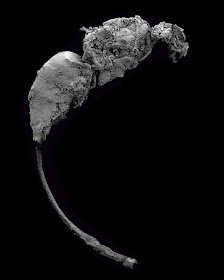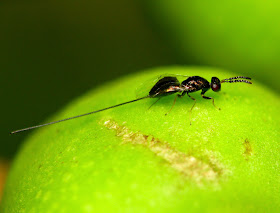 |
| Although it lived roughly 65 million years before the earliest known occurrence of figs, the fossil wasp’s ovipositor closely resembles those of today’s fig wasps. [Credit: Sam Heads] |
“This is a tiny parasitic wasp, it’s the smallest fossil wasp found in this particular deposit and it’s the oldest representative of its family,” said Sam Heads, a paleoentomologist at the Illinois Natural History Survey at the University of Illinois. “More importantly, it’s possible that this wasp was fig-associated, which is interesting because it’s Early Cretaceous, about 115 to 120 million years old. That’s a good 65 million years or so prior to the first occurrence of figs in the fossil record.”
Heads worked in collaboration with University of Portsmouth scientists Nathan Barling and David Martill.
The new findings demonstrate the value of studying insect fossils, Heads said.
“The fossil record of insects is very extensive both geographically and temporally. It goes back 415 to 420 million years and preserves the ancestral forms of a lot of the insects that are alive today,“ he said. ”So it’s a great resource for understanding insect evolutionary history and the distribution of insects across the planet in the past.”
“There is no evidence of the existence of figs at this time and the most recent molecular study doesn’t place figs that far back,” he said. While it is possible that figs are older than current studies indicate, it is also possible that “something like a fig was around and this wasp was parasitizing whatever that was.”
This could be an example of convergent evolution, where separate species independently evolve similar traits, he said. Or the fossil wasp could be the ancestor of the fig wasp, and its ovipositor, first adapted to a plant or fruit that was around long before the fig, later found a use in figs.
Comparing insect fossils with living organisms offers new insights into the natural history of insects, the plants they pollinate and their hosts or prey, Heads said. This differs significantly from studies of the fossils of animals that have become extinct.
“When you talk about paleontology to people the first thing they think of is dinosaurs,” he said. “And that’s great. Dinosaurs are really exciting, wonderful animals. But for the most part, they’re extinct. With insects and other arthropods like spiders and scorpions, they’re around still. So we have modern forms to compare our fossil forms to, which is incredibly useful.”


No comments:
Post a Comment